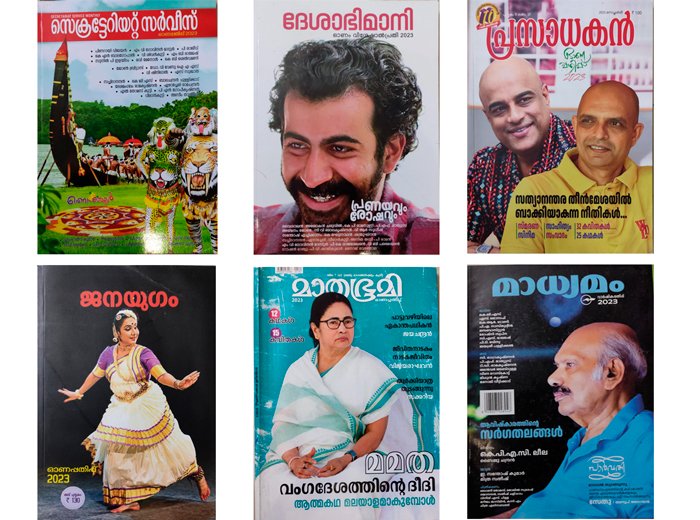
Literature and festivals have always had a close connection – be it Onam in Kerala, Durga Puja in Bengal, or Bihu in Assam. These are times to celebrate and rejuvenate the mind and soul with some food for thought – with some literature, which takes the form of festive magazines and supplements. Magazines that include the words of the literary high and mighty as well as the aspiring all and sundry.
Onam is a harvest festival celebrated by Malayalis in the Malayalam month of Chingam, which corresponds to mid-August to about mid-September on the Gregorian calendar. According to Malayali tradition, it symbolizes the yearly return of King Mahabali through the values of equality, prosperity, and harmony.
During the festival, Malayalis decorate the entrance of their homes with athapookkalam, a type of floral carpet created by adding a layer of flowers each day from atham (the first day of Onam) to thiruvonam (the tenth or final day of the 10 day festival). In modern times, many make the pookkalam on thiruvonam with lamps arranged in the middle or on the edges. Swings are put over trees and courtyards and traditional games such as uriyadi, vadam vali (tug of war), vallam kali (boat race), and pulikkali (masquerading as tigers) are played. Malayalis perform a special kind of dance called Thiruvathira, often to the tunes of onappatt (Onam special folk songs) sung by the legend Yesudas and others. Women adorn new Kasavu sarees while men don the mundu (dhoti), both in white with gold borders.
The Onam Sadya is a grand vegetarian feast served on banana leaves. It includes a variety of dishes over nine courses with around 20-30 different items ranging from avial, sambhar, rasam, pulissery, olan, kaalan, thoran, pachadi, banana chips, and payasam (kheer). This elaborate feast serves as a symbol of unity.
This is the time to celebrate art and culture – when Malayalam newspapers, periodicals, and magazines come out with annual issues referred to as Onappathipp (Onam special editions). Newspaper stands and bookstores in Kerala are flooded with vibrant festival publications that include short stories, essays, poems, plays, fiction, interviews, graphic novels and short stories, travelogues, autobiographical write-ups, novellas, and illustrated and cover stories.

Media houses such as Malayala Manorama, Mathrubhumi, and Deshabhimani come out with Onam specials, said Malayalam translator Kabani C. Other publications such as Deepika, Janayugam, Mangalam, Kerala Koumudi, Kalakoumudi, and Samakalika Malayalam also bring out Onam specials with serious content not aimed at the mass market. Thaliru, a children’s magazine, and online publications also publish festive editions, she added.
The tradition of bringing out Onam supplements began before 1956, she said, adding that when the state of Kerala was formed in 1956, many Malayalam magazines in publication were already bringing out Onam festive editions.
“The Manorama Onam special used to have a circulation of about one lakh copies, though it’s not clear whether the dip in magazine circulation has affected them too,” she told
Indian Printer & Publisher. Onam specials are available outside Kerala as Malayala Manorama and Mathrubhumi have editions in Delhi, Mumbai, Chennai, Bengaluru, Hyderabad and the Gulf countries. The Onam supplements are also available for eReading through online apps such as Magzter.
The Malayalam periodicals save the best stories of the year for Onam specials, she said, adding it is a great advertisement opportunity for magazines and brands alike as Onam is an auspicious time to make purchases. It is a big revenue opportunity for magazines and newspapers that bring out these multi-volume supplements, often offering extra remuneration to writers, she added.
Last year, all Onam editions of mainstream periodicals were published in two volumes and were priced between Rs 120 and Rs 160. There were more than 250 pages in all editions – Mathrubhumi had 548 pages, Madhyamam 292, Deshabhimani 484, while Janyugam had 388 pages, Dr C V Suresh, teacher and author, told Indian Printer & Publisher.
Care is taken to satisfy readers of all levels with stories, poems, articles, interviews, features, travelogues, and autobiographies, he said.
In the 2023 Onam specials, 30 poems were published in Mathrubhumi, 28 in Deshabhimani, and 20 in Madhyamam while 25 stories were featured in Mathrubhumi, 12 in Madhyamam, and eight in Deshabhimani, he said. Among poets, Sachidanandan and K G Shankarapilla were seen in almost all the versions, while T Padmanabhan and C Radhakrishnan were the popular story writers. “The Prasadhakan came in a single volume of 324 pages for Rs 100. It was a magnificent production with 25 stories and 32 poems,” he said.
“Sunil Njaliath presented the life of Mamata Banerjee as a feature in Mathrubhumi. Zakaria’s Turkey travelogue was good. In Mathrubhumi, I enjoyed stories such as N Prabhakaran’s Gloria, Chandramathi’s Elivatorile Pranayam (Love in an Elevator), and T D Ramakrishnan’s Abhayarthi (Refugee). Among poems, Aaratri by P P Ramachandran and Ammu Deepa’s Jalappedi (Fearing Water) stood out,” he said.
The section on books in Deshabhimani was interesting and an interview with Mahua Moitra in the Madhyamam was good, he said, adding the efforts to create an Onam special reading season have largely been successful.
“I remember me as a young reader trying to complete all the Onam specials available,” Kabani said, adding she is looking forward to this year’s specials. “As a reader, I look forward to interesting works of creative writing, special cover stories as well as interviews in Onappathipp 2024,” Suresh said.















